Santoshi wife of Indian Army Colonel B. Santosh Babu, mourns after receiving the uniform and National flag during the last rites ceremony at their home town at Suryapet, about 140 kilometers (87.5 miles) from Hyderabad, India, Thursday, June 18, 2020. Babu was among the twenty Indian troops who were killed in the clash Monday night that was the deadliest conflict between the sides in 45 years. India on Thursday cautioned China against making "exaggerated and untenable claims" to the Galvan Valley area even as both nations tried to end a standoff in the high Himalayan region where their armies engaged in a deadly clash. (AP Photo/Mahesh Kumar A.)
The Associated Press
NEW DELHI (AP) - India said Thursday it was using diplomatic channels with China to de-escalate a military standoff in a remote Himalayan border region where at least 20 Indian soldiers were killed this week.
Responding to China's claim to the disputed Galwan Valley, India's External Affairs Ministry spokesman Anurag Srivastava said both sides agreed to handle the situation responsibly.
"Making exaggerated and untenable claims is contrary to this understanding,'ť he said in a statement.
Monday's clash that killed 20 Indian troops was the deadliest between the sides in 45 years. China has not said whether it suffered any casualties. India also denied reports that any of its troops were in Chinese custody.
Both sides accused each other of instigating the clash in the valley, part of the disputed Ladakh region along the Himalayan frontier.
In the thin air at 14,000 feet above sea level, soldiers brawled with clubs, rocks and their fists but no shots were fired, Indian officials said. Neither side's patrolling soldiers can use firearms under a previous agreement in the dispute.
Defense analyst Ajai Shukla tweeted a photo of rods studded with nails that were purportedly used by Chinese troops.
China maintained that Indian troops had deliberately provoked the clash, though it also signaled it wanted talks, noting the importance of their broader bilateral relationship.
Foreign Ministry spokesperson Zhao Lijian, citing Chinese Foreign Minister Wang Yi in a call with his Indian counterpart, said that 'œmutual respect and support serves our long-term interests."
'œAfter the incident, China and India communicated and coordinated through military and diplomatic channels,'ť he said at a daily briefing. 'œThe two sides agreed to deal fairly with the serious events caused by the conflict in the Galwan Valley, and ... cool down the situation as soon as possible.'ť
But emotions were high in the south Indian city of Hyderabad, where thousands watched the funeral procession of Indian Col. Santosh Babu. He was among the 20 Indian forces who officials said died of injuries and exposure after the clash in the area's subfreezing temperatures.
In McLeod Ganj, the seat of the Tibetan government-in-exile in the Himalayan state of Himachal Pradesh, demonstrators shouted anti-China slogans and burned the Chinese flag.
An Indian confederation of small and midsize companies called for a boycott of 500 Chinese goods, including toys and textiles, to express 'œstrong criticism'ť of China's alleged aggression in Ladakh.
The call for a boycott followed protests Wednesday in New Delhi where demonstrators destroyed items they said were made in China while chanting, 'œChina get out.'ť
The Himalayan clash has fanned growing anti-Chinese sentiments due to the coronavirus. India counts more than 366,000 virus cases and 12,200 deaths.
But a broader boycott could backfire for India if China chose to retaliate by banning exports of the raw materials used by India's pharmaceutical industry.
India's External Affairs Minister Subrahmanyam Jaishankar said all Indian troops at Galwan were carrying arms on Monday. But under 1996 and 2005 agreements between the two countries, they are not supposed to use firearms during confrontations, he said on Twitter.
He was apparently responding to criticism by opposition Congress party leader Rahul Gandhi who wanted to know 'œwhy were our soldiers sent unarmed to martyrdom?'ť
The clash escalated a standoff in the disputed region that began in early May, when Indian officials said Chinese soldiers crossed the boundary at three different points, erecting tents and guard posts and ignoring warnings to leave. That triggered shouting matches, stone-throwing and fistfights, much of it replayed on TV news channels and social media.
Wang, China's foreign minister, warned New Delhi not to underestimate Beijing's determination to safeguard what it considers its sovereign territory. His comments came in a phone call Wednesday with Jaishankar.
Wang said China demanded that India conduct a thorough investigation and 'œharshly punish'ť those responsible.
Jaishankar, in turn, accused China of erecting a structure in the Galwan Valley, which he called a 'œpremeditated and planned action that was directly responsible for the resulting violence and casualties," according to a statement.
He added that the incident would have 'œserious repercussions'ť on India's relationship with China, but that both sides were committed to further disengaging in the remote Himalayan plateau.
While experts said the two nations were unlikely to head to war, they also believe easing tensions quickly will be difficult.
China claims about 90,000 square kilometers (35,000 square miles) of territory in India's northeast, while India says China occupies 38,000 square kilometers (15,000 square miles) of its territory in the Aksai Chin Plateau in the Himalayas, a contiguous part of the Ladakh region.
India unilaterally declared Ladakh a federal territory while separating it from disputed Kashmir in August 2019. China was among the handful of countries to condemn the move, raising it at international forums, including the U.N. Security Council.
India on Thursday was elected to a seat on the Council.
Thousands of soldiers on both sides have faced off over a month along a remote stretch of the 3,380-kilometer (2,100-mile) Line of Actual Control, the border established following a war between India and China in 1962 that resulted in an uneasy truce.
Indian army officers carry the coffin of Colonel B. Santosh Babu for his funeral in Suryapet, about 140 kilometers from Hyderabad, India, Thursday, June 18, 2020. Babu was among the twenty Indian troops who were killed in the clash Monday night that was the deadliest conflict between the sides in 45 years. India on Thursday cautioned China against making "exaggerated and untenable claims" to the Galvan Valley area even as both nations tried to end a standoff in the high Himalayan region where their armies engaged in a deadly clash. (AP Photo/Mahesh Kumar A.)
The Associated Press

Indian army soldiers and family members pay tribute to Colonel B. Santosh Babu during a funeral at his home town at Suryapet, about 140 kilometers from Hyderabad, India, Thursday, June 18, 2020. Babu was among the twenty Indian troops who were killed in the clash Monday night that was the deadliest conflict between the sides in 45 years. India on Thursday cautioned China against making "exaggerated and untenable claims" to the Galvan Valley area even as both nations tried to end a standoff in the high Himalayan region where their armies engaged in a deadly clash. (AP Photo/Mahesh Kumar A.)
The Associated Press
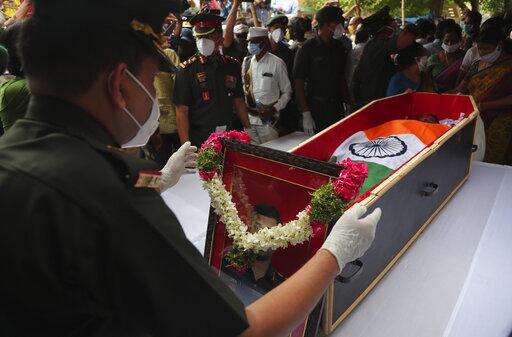
An Indian army officer pays tribute to Colonel B. Santosh Babu during his funeral in Suryapet, about 140 kilometers from Hyderabad, India, Thursday, June 18, 2020. Babu was among the twenty Indian troops who were killed in the clash Monday night that was the deadliest conflict between the sides in 45 years. India on Thursday cautioned China against making "exaggerated and untenable claims" to the Galvan Valley area even as both nations tried to end a standoff in the high Himalayan region where their armies engaged in a deadly clash. (AP Photo/Mahesh Kumar A.)
The Associated Press
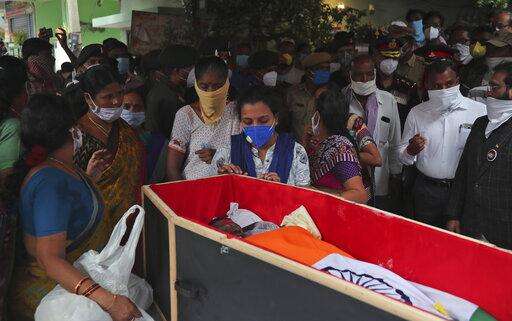
Santoshi, center, mourns by the coffin of her husband Colonel B. Santosh Babu during a funeral at their home town at Suryapet, about 140 kilometers from Hyderabad, India, Thursday, June 18, 2020. Babu was among the twenty Indian troops who were killed in the clash Monday night that was the deadliest conflict between the sides in 45 years. India on Thursday cautioned China against making "exaggerated and untenable claims" to the Galvan Valley area even as both nations tried to end a standoff in the high Himalayan region where their armies engaged in a deadly clash. (AP Photo/Mahesh Kumar A.)
The Associated Press

B. Upender weeps by the coffin of his son Colonel B. Santosh Babu in Suryapet, about 140 kilometers from Hyderabad, India, Thursday, June 18, 2020. Babu was among the twenty Indian troops who were killed in the clash Monday night that was the deadliest conflict between the sides in 45 years. India on Thursday cautioned China against making "exaggerated and untenable claims" to the Galvan Valley area even as both nations tried to end a standoff in the high Himalayan region where their armies engaged in a deadly clash. (AP Photo/Mahesh Kumar A.)
The Associated Press
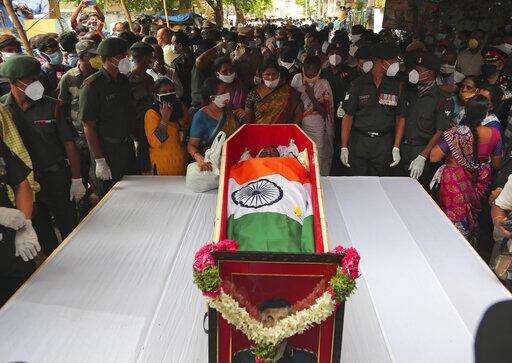
Indian army officers and family members pay tribute to Colonel B. Santosh Babu during his funeral in Suryapet, about 140 kilometers from Hyderabad, India, Thursday, June 18, 2020. Babu was among the twenty Indian troops who were killed in the clash Monday night that was the deadliest conflict between the sides in 45 years. India on Thursday cautioned China against making "exaggerated and untenable claims" to the Galvan Valley area even as both nations tried to end a standoff in the high Himalayan region where their armies engaged in a deadly clash. (AP Photo/Mahesh Kumar A.)
The Associated Press
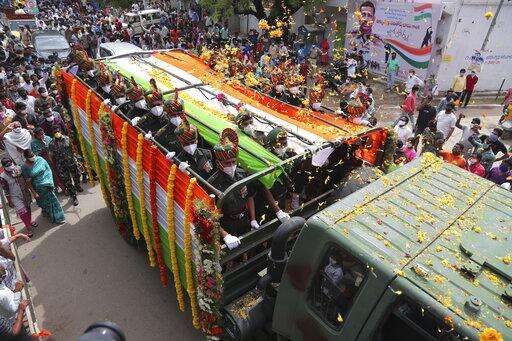
A truck carrying the coffin of Indian army officer Colonel B. Santosh Babu arrives in Suryapet, about 140 kilometers from Hyderabad, India, Thursday, June 18, 2020. Babu was among the twenty Indian troops who were killed in the clash Monday night that was the deadliest conflict between the sides in 45 years. India on Thursday cautioned China against making "exaggerated and untenable claims" to the Galvan Valley area even as both nations tried to end a standoff in the high Himalayan region where their armies engaged in a deadly clash. (AP Photo/Mahesh Kumar A.)
The Associated Press
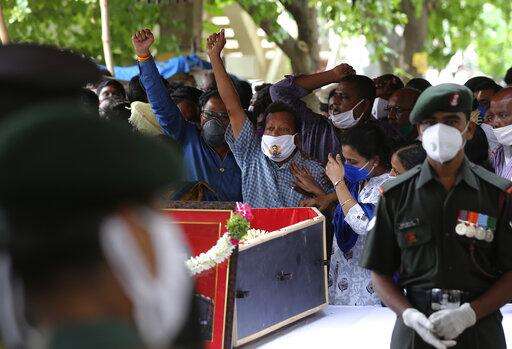
People gathered shout slogans during the funeral of Colonel B. Santosh Babu in Suryapet, about 140 kilometers from Hyderabad, India, Thursday, June 18, 2020. Babu was among the twenty Indian troops who were killed in the clash Monday night that was the deadliest conflict between the sides in 45 years. India on Thursday cautioned China against making "exaggerated and untenable claims" to the Galvan Valley area even as both nations tried to end a standoff in the high Himalayan region where their armies engaged in a deadly clash. (AP Photo/Mahesh Kumar A.)
The Associated Press

Indian shout slogans and call for boycott of Chinese products during a demonstration in Gauhati, India, Thursday, June 18, 2020. Twenty Indian troops who were killed in the clash Monday night that was the deadliest conflict between the sides in 45 years. India on Thursday cautioned China against making "exaggerated and untenable claims" to the Galvan Valley area even as both nations tried to end a standoff in the high Himalayan region where their armies engaged in a deadly clash. (AP Photo/Anupam Nath)
The Associated Press

An Indian guard steps out of an electronics shop that has stopped selling Chinese products in Gauhati, India, Thursday, June 18, 2020. An Indian confederation of small and midsize companies called for a boycott of 500 Chinese goods, including toys and textiles, to express 'strong criticism' of China's alleged aggression in Ladakh. The call for a boycott followed protests Wednesday in New Delhi where demonstrators destroyed items they said were made in China while chanting 'China get out.' AP Photo/Anupam Nath)
The Associated Press
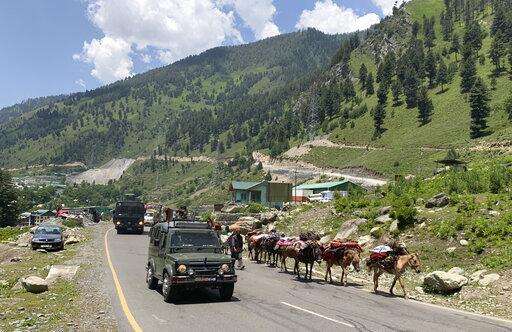
An Indian army convoy moves on the Srinagar- Ladakh highway at Gagangeer, north-east of Srinagar, Indian controlled Kashmir, Thursday, June 18, 2020. India on Thursday cautioned China against making "exaggerated and untenable claims" to the Galwan Valley area even as both nations tried to end a standoff in the Himalayan region where their armies engaged in a deadly clash. Twenty Indian troops were killed in Monday's clash, which was the deadliest conflict between the sides in 45 years. China has not disclosed whether its forces suffered any casualties. (AP Photo)
The Associated Press